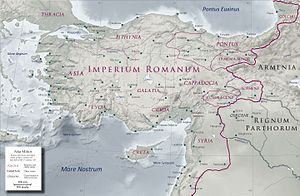Bithynia and Pontus
This article needs additional citations for verification. (October 2018) |
| Provincia Bithynia et Pontus Επαρχία Βιθυνίας και Πόντου | |||||||||||||||
|---|---|---|---|---|---|---|---|---|---|---|---|---|---|---|---|
Diocletian Reforms | c. 300 AD | ||||||||||||||
| |||||||||||||||
| Today part of | Turkey | ||||||||||||||
Bithynia and Pontus (
In 74 BC,
The Populares held both consulships at Rome.
The wealth of Anatolia was now at Rome's command. It was Pompey's task to
Geography
The
History
The
Republican civil wars
Bithynia and Pontus became an important player during the
With the Caesar in Egypt,
After defeating the Ptolemaic forces at the
In 45 BC, Caesar, now dictator of Rome, appointed Quintus Marcius Crispus as governor of Bithynia and Pontus. Following Caesar's assassination on March 15, 44 BC, by the members of the Roman Senate, Marcus Junius Brutus and Gaius Cassius Longinus fled from Italy and assumed command of the Republic's eastern provinces, including Bithynia and Pontus, in 43 BC. When Crispus refused to serve the assassin of his patron, Cassius had him removed from office and forced into retirement. Following the defeat of Brutus and Cassius by the Second Triumvirate at the Battle of Philippi in 42 BC, Triumvir Mark Antony assumed command of the Republic's eastern provinces.
The Second Triumvirate expired in 33 BC, ending Antony's legal right to govern the Eastern half of the Republic. With the Triumvirate lapsed, the struggle for dominance between Antony and
Rump State

In 39 BC, Antony stripped control of Lesser Armenia (the remnants of the former Kingdom of Pontus) from the rulership of the Cappadocian king Ariarathes X of Cappadocia and made Darius of Pontus, son of Pharnaces II of Pontus, the Roman client king of Pontus. Antony also granted to Darius the rulership of the Roman client kingdom of Cilicia. His reign lasted until his death in 37 BC, after which Antony appointed Polemon I of Pontus as client king of Cilicia and Arsaces of Pontus as client king of Lesser Armenia.
Following Arsaces' untimely death the next year in 36 BC, Antony appointed Polemon I as client king of Pontus. Years later, in 16 BC, Polemon I, at the request of
Following Polemon I's death in 8 BC, he was succeeded by his stepson
Pythodorida was succeeded by her stepson
Principate

As part of the
Senatorial provinces, conversely, were centered along the Mediterranean Sea and did not possess any significant military force; the province of Bithynia and Pontus, being located along the southern Black Sea coast, was an exception although it too lacked any significant garrison. Augustus allowed the Senate to appoint the governors of these provinces as it had done with all provinces under the Republican system: a sortition was used to select a proconsul who would have imperium over the territory, and be assisted by a legatus or a lieutenant governor, and quaestor who handled financial issues.
The Roman writer Pliny the Younger was governor of the province in AD 110-113. His Epistulae ("Letters") to emperor Trajan (ruled 98-117) are a major source on Roman provincial administration.
The cities of Bithynia took on many features of Roman cities (e.g. councils of
According to Cassius Dio, around AD 134 the Senate ceded control of Bithynia and Pontus to the Emperor in return for Lycia et Pamphylia.[3]
Dominate
Under the administrative reforms of emperor
Legacy
Following the Muslim invasions of the 640s AD, the
See also
- List of Roman governors of Bithynia and Pontus
- Kingdom of Pontus
- Mithridates VI of Pontus
Footnotes
- ^ Richard Talbert, The Senate of Imperial Rome (Princeton: University Press, 1984), p. 392
- ISBN 9782753514355.
- ^ Talbert, Senate, p. 395
Bibliography
- French, David H (2013). "Fasc. 3.4 Pontus et Bithynia (with northern Galatia)". Roman Roads & Milestones of Asia Minor (PDF). Electronic Monograph 4. Vol. 3 Milestones. Ankara: British Institute. ISBN 9781898249283. Archived from the original(PDF) on 2022-01-07. Retrieved 2017-11-05.
- Zając, Barbara (2023). Between Roman culture and local tradition: Roman provincial coinage of Bithynia and Pontus during the reign of Trajan (98-117 AD). Oxford: Archaeopress. ISBN 9781803274652.

